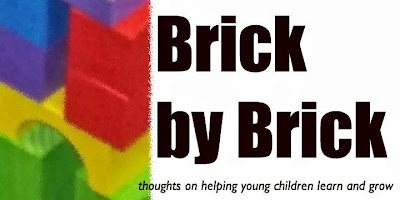All you need for fork painting: Shallow pans, paper towels, paint, forks, and paper. (We always use smocks, too.)
Fold and wet paper towel and place in the shallow pan. Pour paint on top of the paper towel. This creates a "stamp pad" with the paint. Kids can press the fork on the paint and get good coverage. This also keeps the paint in one place. You can get more art with less paint.
I gave no directions for the fork painting. Kids put on smocks, picked up the forks, and began to explore. The first few kids make swiping motions with the back of the fork. This allows a great deal of coverage.
I mentioned that the fork could be used to make lines, too. The girls experimented with pulling the fork tines along the paper. They also tried making dots with the ends of the fork tines. It did work, but the dots were very small and not very interesting. There were lots of other interesting things to do.
The kids told me that yellow and blue together make green. Then we experimented with some color mixing. We made lots of different shades of green. One girl decided that using blue first (then adding yellow) made a different color of green than using the yellow first (and then adding blue).
Those kids left the table. Later another one came to the table. I showed him the materials and he began to explore. He did something completely different from the earlier girls.
He began to make prints. He pressed the fork in the paint and then onto his paper. He made lots and lots of prints. He began to experiment with mixing the two colors, too. He would press a yellow fork on top of a blue print. He even put two forks together, one on the other, to see what would happen.
Another boy joined the activity and began to make prints, too. He observed what his friend was doing and mimicked the action. I mentioned that there were other ways to use the fork to paint, but they both continued to make prints. Then the second boy began to connect his prints together to make longer lines.
He worked a long time, adding blue or yellow in just the right places to create what he wanted. When he finished, he said to me, "It's a beach."
Looks like water and sand--the beach--to me!
These types of process art activities are just what I want. How do I know it's a process art activity? Each one looks different.
And, as I look at each one, I can think about all the different things that the kids did. Things that are not readily evident from the finished painting.
I remember the thinking and conversation that happened. Each one reveals that the child was experimenting and exploring. Each one shows what was important to that child as he worked.
That's where the important stuff happened - during the doing, the process. These beautiful works of art are just the captured result of a lot of learning.
Not bad for some plastic forks.










